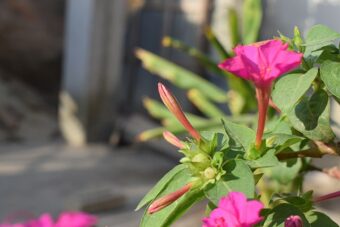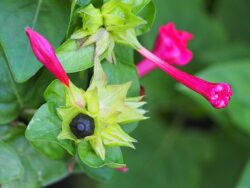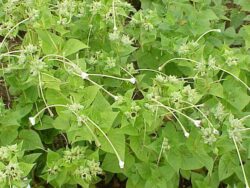In this article, we will discover how to grow the beautiful flowering Mirabilis in containers. If you have holidayed abroad in the Mediterranean, you will have seen this tender, tuberous rooted perennial growing. Its Latin name is Mirabilis jalapa and is often grown for its flowers that open in the afternoon (hence the common name of the Four o’clock plant). It is a leafy plant that forms a rounded bush that is easy to overlook during the day.

Later on in the afternoon, the flowers open that are magenta-purple or crimson orange and sometimes orange, yellow or striped. What is surprising is that you can get a mixture of all these colours all together on the same plant. The blooms remain open all night and are produced profusely all summer long, where the scent can be enjoyed.
GROWING MIRABILIS IN CONTAINERS
You have a choice to how to grow Mirabilis, either from seed or shop-bought plants,
To grow from seed, you will need to sow seeds 4 to 6 weeks before the last frosts of spring. To do this, fill a seed tray with a good quality seed sowing compost. Water until the compost is moist and then gently sprinkle the seed on top thinly, Cover the seeds with a 3m layer of sieved seed compost and then place a propagator lid on top of the seed tray.
Place the seed tray on a heated propagator on a heat mat, where you will need to wait for 7 to 10 days for the seeds to germinate. Once they have done so, you will need to remove the propagator lid off and allow the seedlings to grow on.
Once two true leaves have emerged, it is time to transplant them. At this stage, prick the seedlings out and transplant them to 7.5cm pots full of multipurpose compost individually. Allow the plants to grow on and in Mid-May you can start to harden the plants off before planting out in late May.
At this stage, you can treat home-reared seed grown plants and shop-bought, garden-ready plants in the same way.
GROWING IN A CONTAINER

First, choose a large enough container that will suit the plant in question. Whatever you choose make sure it has plenty of drainage holes in them. Add a 1cm layer of gravel to the bottom of the container to help with drainage and on top of this add a good quality, multipurpose compost.
Dig a hole that is slightly bigger than the root ball of the original plant. Drop the plant in so that the top of the root ball is at the same level as the top surface of the compost. Backfill with the growing media, ensuring that any gaps that remain are filled with more compost. Firm the plant in and water well.
Place the container where its fragrance can be most appreciated. By the side of a door in a sunny location is ideal, where it can mingle with other flowering plants.
GROW THEM IN FULL SUN

Grow your Mirabilis in full sun as they do best under these conditions. In partial shade, it will become leggy and will not bloom profusely. You will need to water frequently throughout the growing season, especially when 5cm below the top of the surface of the compost feels dry to the touch. Water until it emerges from the drainage holes, but do not overwater as this can cause soggy compost, leading to root rot.
It is often grown as an annual in the UK unless you are prepared to move them inside a conservatory and protection from cold weather over winter, you can either bring the whole pot in or otherwise, you can dig up the tubers and store them in a frost-free location (like a dry garage or shed) as you would a tuberous begonia. In spring, you can plant the tubers again to produce its flowers in the next growing season.
In spring and once flowering begins you will need to feed every 2 weeks with a high potash liquid fertilizer such as phostrogen. Alternatively, you can use a slow-release fertilizer when planting the tubers in spring.
When the plant is young, you will need to pinch the growing tips out to promote bushier growing habits and more flowers. Late in the summer of the weather has been hot the plant will look sluggish. At this time cut the stems by a third to give a new flush of growth and flowers.
PESTS AND DISEASES
The good news is that the plant is pest and disease resistant. Saying that they can suffer from fungal diseases such as rust and leaf spot diseases that can affect leaves. The best way to avoid this is to apply fungicide to stored tubes and to plant in new compost every year. Aphids can be a problem and slugs may find the tender new shoots too much to resist. Deal with aphids by using sprays of water jets and pellets to deal with slugs.
VARIETIES TO GROW
The following varieties are recommended to be grown in containers:
‘Alba’ produces white flowers and a light citrus scent where it will self-seed everywhere.
‘Tingles’ produces small flowers of multiple colours.

‘Kaleidoscope’ produces multi-coloured blooms of pink yellow and white with bright coloured splashes and streaks.
‘Broken Colour’ produces flowers in a range of colours, all splashed a marble in cerise red.
Mirabilis longifolia produces highly fragrant, trumpet-like flowers that are white with a splash of pink in them.
CONCLUSIONS
In this article, we have discussed how to grow Mirabilis in containers to give wonderful colour and scent. They are easy to grow from seed and you can save them to grow and replant next spring. They tend to be pests and diseases free especially if they are looked after right.
They are such wonderful plants, bringing so much colour and scent that you wish that you grow them earlier.
If you have any questions or comments that you wish to make on growing Mirabilis in containers, please do so in the comment box below.
Happy Mirabilis growing.

The leaves have became yellowish. I was wondering, is it because of lack or too much water. Thank you
Hi Danielle
Tyellowing of leaves is often due to too much water but could also indicate that it lacks nutrients, Feed it and make sure the compost is not too wet. Older leaves turning yellow are normal and should be removed.
Thanks
Antonio